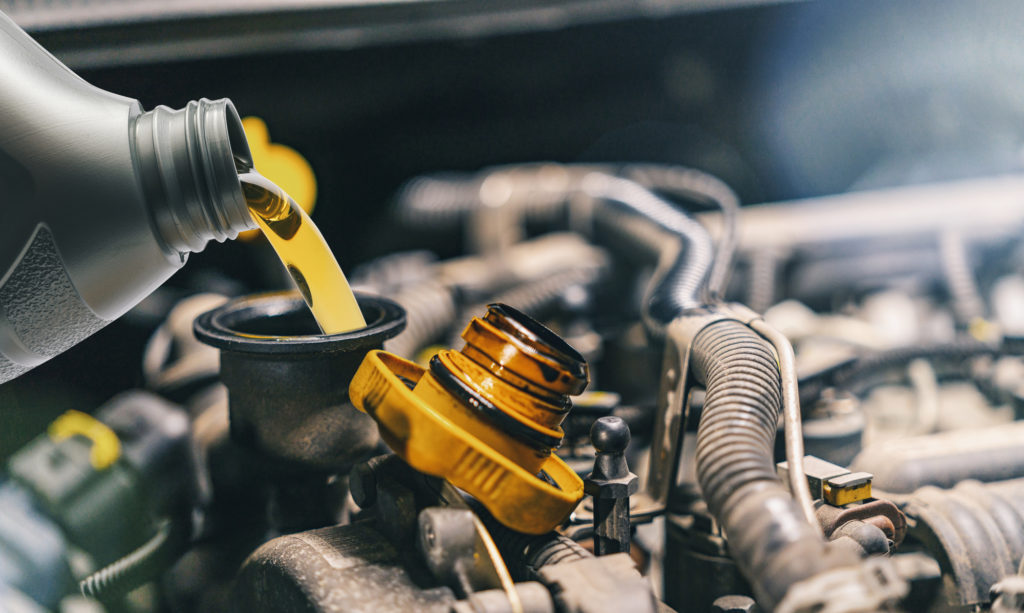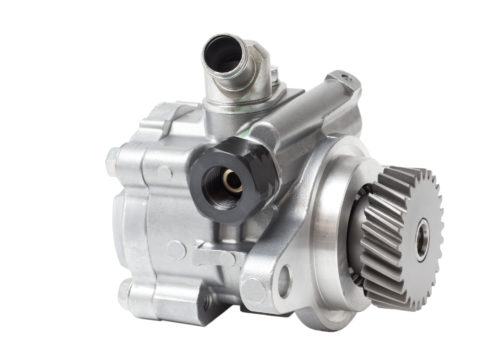If you bought a car some time ago and are now just getting to the point where you need to change your car’s oil, you might be a bit unsure what all the notation for the different engine oils means. For example, what’s the difference between 0w20 vs. 5w20? Luckily, you’re in the right place. Keep reading to learn more.

Contents
What Do 0w20 and 5w20 Mean?
These numbers refer to the engine oil’s weight at certain temperatures, e.g., 5W or 0W. It tells you how heavy the oil is when cold and when hot.
Typically, an engine operates at a temperature of about 200°F (93°C). But when you start your car and accelerate the engine, it takes a little while for this temperature to come up. And when it finally does, your engine will cool down quickly once you stop or slow down and idle for a while.
This engine response is why oil weight matters: the heavier the oil, the slower your engine will heat up and cool down. This is important to know for saving oil and fuel.
The professionals grade auto oils according to a standard called the Society of Automotive Engineers (SAE).
The SAE grading system consists of two numbers. The first number, which range from zero to 19, indicates the oil weight in the cold state. The second number falls between 0 and 30. It refers to its thickness in the hot state. For example, according to SAE grading, a 0W-20 oil is lighter and thinner than a 5W-30.
What Is Viscosity?
Viscosity is a vital property of car oil that indicates its resistance to flow. It measures a fluid’s internal friction, caused by its flow. Oil viscosity does not depend only on its weight. It also depends on the base stock – a blend of hydrocarbon chains.
Oil viscosity changes with temperature, so thicker oil flows more slowly and thins out as it heats up.
Additives affect the viscosity of the oil. For example, adding an anti-foaming additive allows the oil to flow more easily and be thinner, even at high temperatures.
To keep their engines running smoothly, drivers need to choose an oil suitable for the climate they live in. Oil viscosity must be chosen based on the temperature range one can expect.
There are two viscosity grades; single grade and multi-grade.
Single-grade oils stay at a constant viscosity, regardless of temperature. Multi-grade oils contain polymers that swell and shrink in different temperatures.
The Benefits of Multigrade Oils
Multigrade oils give you the best of both worlds. Such oils have usefulness across a wide range of temperatures. Since the oil viscosity changes with temperature, it is effective at low and high temperatures.
It is beneficial for the driver because it saves fuel and reduces engine components’ wear, which leads to lower emissions.
However, this may make the viscosity of your oil change seasonally. So, owners should check their oil regularly to see if the grade needs changing.
The downside to using multigrade oil is that they cost more and could cause problems in cold weather when the vehicle starts up.
The choice of oil is ultimately up to the driver, but you should always follow your car manufacturer’s guidelines.
Which Should You Use?
Your chosen oil grade must fit the climate in your region and be effective at controlling engine wear.
SAE 0W-20 and 5W-20 multi-grade oils are ideal for most climates, but 5W-30 is the best in extreme cold.
The choice of oil weight is more complicated than it may appear at first glance. Your car’s owner manual will recommend an oil viscosity and an oil grade.
If the oil is too viscous, it will increase engine wear by restricting metal-on-metal movement and restricting necessary oil circulation. It will overheat the engine and lead to reduced power and efficiency.
If it is too thin, it won’t lubricate the engine sufficiently. So the car will have reduced power and efficiency. There could also be problems with cold-weather starts. The oil will be too thin to lubricate the engine adequately at low temperatures.
How Are SAE Grades Assigned?
Four tests are conducted. Two of these are done at low temperatures (freezing) and the others at higher temperatures (100C).
The results of the first two tests give the oil its first grade – the cold one. The results of the second test give it its other number.
The SAE cold grade indicates the oil’s weight in the cold state. The second number falls between 0 and 30. It refers to its thickness in the hot state.
0w20 vs. 5w20 Thickness
Oil thickness is relevant because thicker oil reduces friction better in comparison to thinner oil. Thicker oils provide more lubrication for moving parts in the engine. However, thinner oils require more frequent oil changes because it is used up at a faster rate.
Oil thickness also affects viscosity. The lower the weight of the oil, the less viscous it is; this allows for faster lubrication before friction occurs.
Viscosity is measured in cSt (centistokes) at a certain temperature. A higher number of cSt indicates thicker oil, whereas a lower number indicates a thinner oil.
The highest viscosity of oil occurs when it is around 40C. However, an oil’s viscosity is different at every temperature, so each grade of oil has its specific number.
The higher the viscosity, the better the load it can support. In other words, a 10W-40 oil is better able to support a load when it is 40C than a 5W-20 oil would be at the same temperature.
0w20 is too thin for trucks and SUVs. It is for lighter use in diesel and petrol engines.
5w20 oil is thicker, which is good for those with higher revving engines or those with a high amount of stop and go with their vehicle. Vans and trucks benefit from 5w20 especially because of their higher revolutions.

What Is the Difference Between 0w20 and 5w20?
Oils fall into weight’ grades with numbers. The first number is the viscosity at cold temperatures, but the second is the viscosity at high temperatures. Oil thickness changes as conditions change – if it’s cold, it becomes thicker. Choose the grade for your climate.
0W is for cold climates where the temperature falls below zero degrees Celsius. 0W-X is for colder climates below -18 degrees Celsius. 5w is ideal for most places, including climates with extreme heat.
“W” refers to winter, so both oils are ideal for use in cold temperatures. 0W-XX oils have a lower viscosity which enables the engine to respond better, while 5W-XX oils have a higher viscosity to maintain protection under extreme conditions.
The first number is viscosity in cold temperatures, and the number after the W is viscosity in warm temperatures. With 0w20, the 0 indicates the viscosity when the engine is cold, and the 20 refers to viscosity at higher temperatures.
Lower values mean oil is thinner (so 0 is thinnest). In 5w20, the 5 is again the oil’s viscosity when the engine is cold and 20 is the same as in 0w20.
Types of 0w20 Oil
- Valvoline VV916 – uses Molybdenum to maintain viscosity at the lowest possible temperature and provides excellent high-temperature protection. It provides excellent wear protection, 0w20 for gasoline engines.
- Budget full synthetic oil – provides quality performance and protection required by modern vehicles, fully synthetic 0w20 for gasoline engines.
- Castrol EDGE FST – it is a continuous, low viscosity oil with Molybdenum for improved protection against wear and corrosion. Get the convenience of one lube for life, 0w20 for gasoline engines.
- Castrol EDGE 5w30 (supreme) – this is a fully synthetic oil that uses a blend of special ingredients. It also has additives to ensure maximum performance. This oil is suitable for petrol and diesel engines, 5w30 for petrol engines.
- Castrol 03124 EDGE – a special blend that provides outstanding performance at temperature extremes. Suitable for diesel engines from 4ltr capacity and above, 0w20 FO petrol engines.
- Liquimoly 2208-108 – offers excellent protection against engine wear in all conditions, especially when used in high-performance turbo diesel engines. Suitable for petrol and diesel engines using 0w20 to 5w30.
- Idemitsu 20102-042B – fully synthetic oil using a blend of ingredients to provide excellent performance at all temperatures, protecting against wear. It is suitable for diesel engines from 3ltr capacity and above, 0w20 FO petrol engines.
- Royal Purple 01020-6PK-i – uses an exclusive additive technology that, when added to conventional or synthetic motor oils, provides superior performance and protection against wear. Suitable for petrol and diesel engines.
- Pennzoil 550046122-3PK – specially designed for use in diesel trucks, SUVs and is intended for lighter use in diesel and petrol engines.
- MAG 1 20139 – thicker than conventional motor oils, providing extra protection and performance. Suitable for petrol and diesel engines using 0w20 to 5w30.
Types of 5w20 Oil
- Valvoline MaxLife 782253 – a high-quality oil that protects against wear for longer. It is suitable for use in petrol and diesel engines, 5w20 for gasoline engines.
- Castrol 03083 EDGE – a special blend that provides outstanding performance at temperature extremes. Suitable for diesel engines from 4ltr capacity and above, 5w20 FO petrol engines.
- Mobile 1 120763 – this is an advanced full synthetic product that ensures maximum protection, performance, and cleanliness in all types of petrol engines.
- Castrol Edge 03086 – a special blend that is suitable for use in high-performance turbo-diesel engines, 5w20 FO petrol engines.
- Valvoline 787023 – a high-quality oil that protects against wear for longer. It is suitable for use in petrol and diesel engines, 5w20 for gasoline engines
- Royal Purple 36520-6PK – a special blend that provides outstanding protection and performance at temperature extremes. Suitable for diesel engines from 5ltr capacity and above, 5w20 FO petrol engines.
- Pennzoil 550038330-5PK – specially designed for use in diesel trucks, SUVs and is intended for lighter use in diesel and petrol engines.
Picking the Right Motor Oil for Your Car
Picking the right oil can save you costs, headaches, and money. Use the correct motor oil for your car, especially if you drive a performance vehicle.
Factors to consider when choosing between 0w20 and 5w20 include:
- the weather where you live
- your driving habits
- how much you use your vehicle
Understand that not all synthetic oils are of the same quality. The best type of oil for your vehicle is one that meets or exceeds your car’s manufacturer-recommended viscosity rating.
Manufacturer Requirements
Owner manuals recommend the viscosity of oil a car requires. Most manufacturers recommend 0w20 for very cold climates and 5w20 for milder weather.
If you drive a lot, you may need a 5w20 oil instead of the usual 0w20. If you rarely drive your car, even though it’s better to use 0w20, you don’t have to put the additional expense into 5w20 if it’s not necessary.
Location
Ow20’s range is -40c to 20c while 5w20’s range is -35c to 20c. Using 5w20 in colder weather won’t cause any problems.
If you live in extremely cold climates, go for 0w20. If you live in a place where temps exceed 20c, both are not recommended.
The best type of oil for your vehicle is one that meets or exceeds your car’s manufacturer-recommended viscosity rating.
Fuel Economy
In choosing an oil, one of the most important things to consider is fuel efficiency. Fuel economy is the amount of fuel your car uses over a distance. Its ratings are calculated based on standard driving conditions, which can be a tough thing to measure in a car with a lot of power.
Using 0w20 in your car for extended periods will not have any impact on your fuel economy.
0w20 has a slight edge over 5w20, but both are thin enough to ensure smooth flow ensuring that most engine parts move without any problem and hence do not require more power.
Price
Prices may vary based on your location but 0w20 will always be slightly more costly due to its efficiency in cold conditions.
5w20 has the edge over 0w20 in terms of cost.
How to Change Your Engine Oil
Most manuals recommend a change of oil every 3-5k miles. However, the frequency in which you need to change your oil will depend on the quality of oil you use and how much you drive.
If you own a performance car, it’s best to change your oil every 1-2k miles to ensure optimal performance. This is why it’s important to choose the right oil for your car.
When you change the oil, replace the filter as well.Change synthetic oil at least every 5k miles for non-performance cars and every 1k miles for performance ones.
If you drive a lot, use 5w20 to save money over time.
Steps to Change Your Car Oil
You can change your car oil yourself and it is simple to do so. You don’t need to use a professional mechanic when you can do it yourself at home.
All you need is an oil filter wrench and a few other basic tools.
- First, let your car cool down for about 10 minutes. Don’t use the hood to prop up the car.
- Park your car on a level surface and use wheel chocks to immobilize the wheels that are in contact with the ground. Engage the parking brake.
- Open the hood and locate the oil cap. It’s usually on the upper left, in front of the engine. Unscrew the cap but make sure you put it aside, as you might need it later.
- Look for the oil drain plug and place a large pan underneath it. Loosen the plug with an oil drain wrench and let your old oil flow into the pan. When done, replace and tighten the drain plug.
- Put the oil filter wrench on the old oil filter and slowly turn it counterclockwise to remove it. Clean the area around the new oil filter.
- A new oil filter only goes on one way. If you find it difficult to fit it, make sure you are putting it in the right way.
- Add the new oil filter and wipe off any remaining oil with a towel. Now pour in the recommended amount of the new, fresh oil.
- Remove the oil filler cap and pour the new oil into it. Close the cap when you fill up all of your car’s oil reservoirs.
- Check if the oil filler cap is tight and wipe up excess oil around it.
- Start your car to let the fresh oil spread inside the engine.
Mixing 0w20 and 5w20
The different oil blends are mainly used for commercial purposes. They help oil companies sell their products and meet the needs of consumers who may only need a certain viscosity.
So you should only use 0w20 and 5w20 as directed by your car’s manual or manufacturer to ensure that your engine runs smoothly and your car is not damaged in any way.
Premium Conventional Oil
This is standard for new cars and covers most engine design and light-duty vehicles. It has a viscosity of 10w30 and is suitable for engine temperatures as low as -20c.
It’s recommended to use premium standard oil for all-wheel drive (AWD) cars and performance cars.
Fully Synthetic Oil
This type of oil is also called “premium full synthetic.” It’s suitable for most cars and conditions, but the viscosity of this oil may not last in extremely low or extremely high temperatures.
It’s usually recommended for newer cars to ensure they have protection against damage due to the changing viscosity of oil in extreme conditions.
It is compatible with high-tech engines like Corvettes and Mercedez-Benz engines and has a viscosity of 5w20 or 0w20.
This type of oil has superior, longer-lasting performance than premium standard. Use this oil for high-performance cars, all-wheel drive (AWD), and four-wheel drive (4×4) cars.
However, fully synthetic oil is not meant for all engine types, so use as directed by your car’s manual.
Synthetic Blend Oil
Synthetic oil mixed with organic oil is also available. This oil has similar benefits of being able to handle extreme temperatures while protecting cars. It’s compatible with all engine types, which is why it’s suitable for most cars.
It offers a viscosity of 5w20. It provides better engine protection when compared to conventional oil, but some drivers have complained of sludge buildup.
It reduces oil loss and increases fuel economy, so it is good for pickups or SUVs.
Higher-mileage Oil
This oil caters to older vehicles with more than 75,000 miles on their engines. It contains added additives to improve the effectiveness in older engines and has a viscosity of 5w30.
It’s compatible with most engines, but should only be used under the guidance of your manual.
Most people are cautious of mixing 0w20 and 5w20. With all the different oil options, it can be hard to know which one to use. To avoid damage, only mix 0w20 and 5w20 if your manual specifically states that the two are compatible.
Doing so may void your manufacturer warranty and cause irreversible damage to your car. It’s best to speak to a mechanic before making any changes.
0w20 is fully synthetic oil, but 5w20 is often partially synthetic. Even if it is fully synthetic, consider the warranty and fuel consumption of each engine. For both types, change the engine oil regularly. Do not overfill the engine with oil, and check your levels regularly to avoid any mishaps.
Ow20 is very thin and suited for modern engines that need the minimum weight and viscosity to protect them. Use 0w20 in cold climates because it flows even at very low temperatures. 0w20 is best suited for turbocharged engines due to its high flow properties. It works excellently in variable conditions. It starts to thin out when it reaches higher temperatures.
FAQs
Finally, let’s wrap up with some common questions people ask about 0w20 vs. 5w20.
Can older cars use synthetic oil?
Older cars can use synthetic oil, but a mechanic should check it first. When dealing with this yourself, don’t forget to reference the manual.
Is synthetic oil compatible with diesel and gasoline engines?
Yes, it is compatible with both engine types.
Are 0w20 and 5w20 interchangeable?
No, they are not interchangeable. Follow the recommendations in your car manual.
Should you switch oils depending on the season?
No. The best practice is to use synthetic oil and check your levels regularly.
Can you use 0w20 instead of 5w20 for Honda/Toyota?
No, you should use the oil as directed by your car’s manual.














